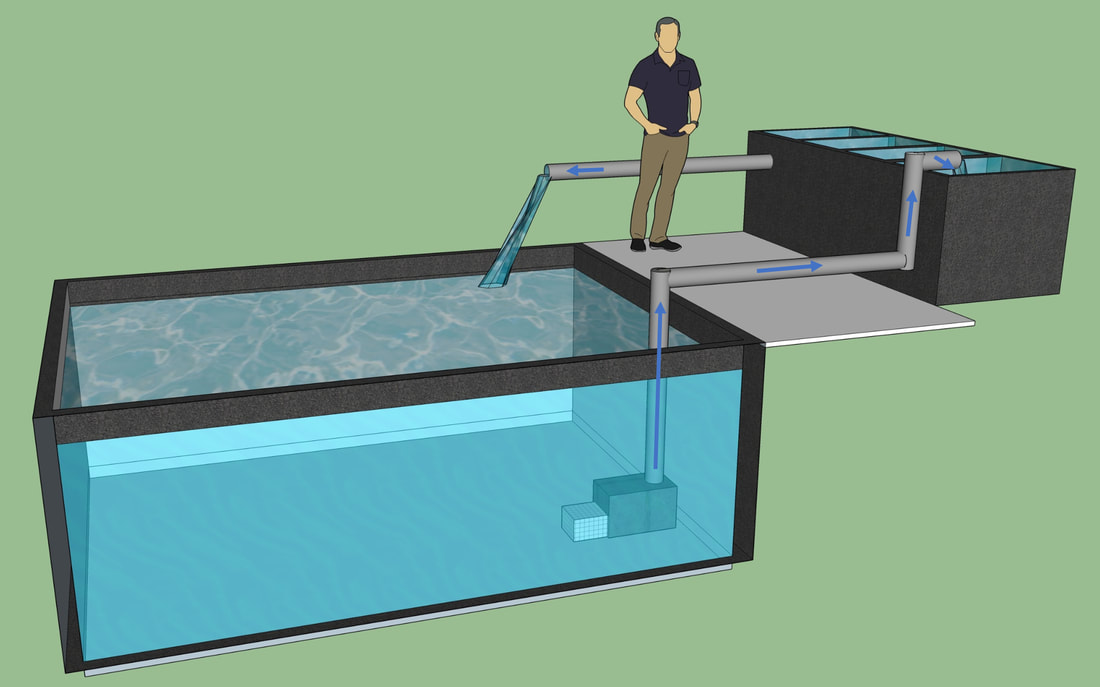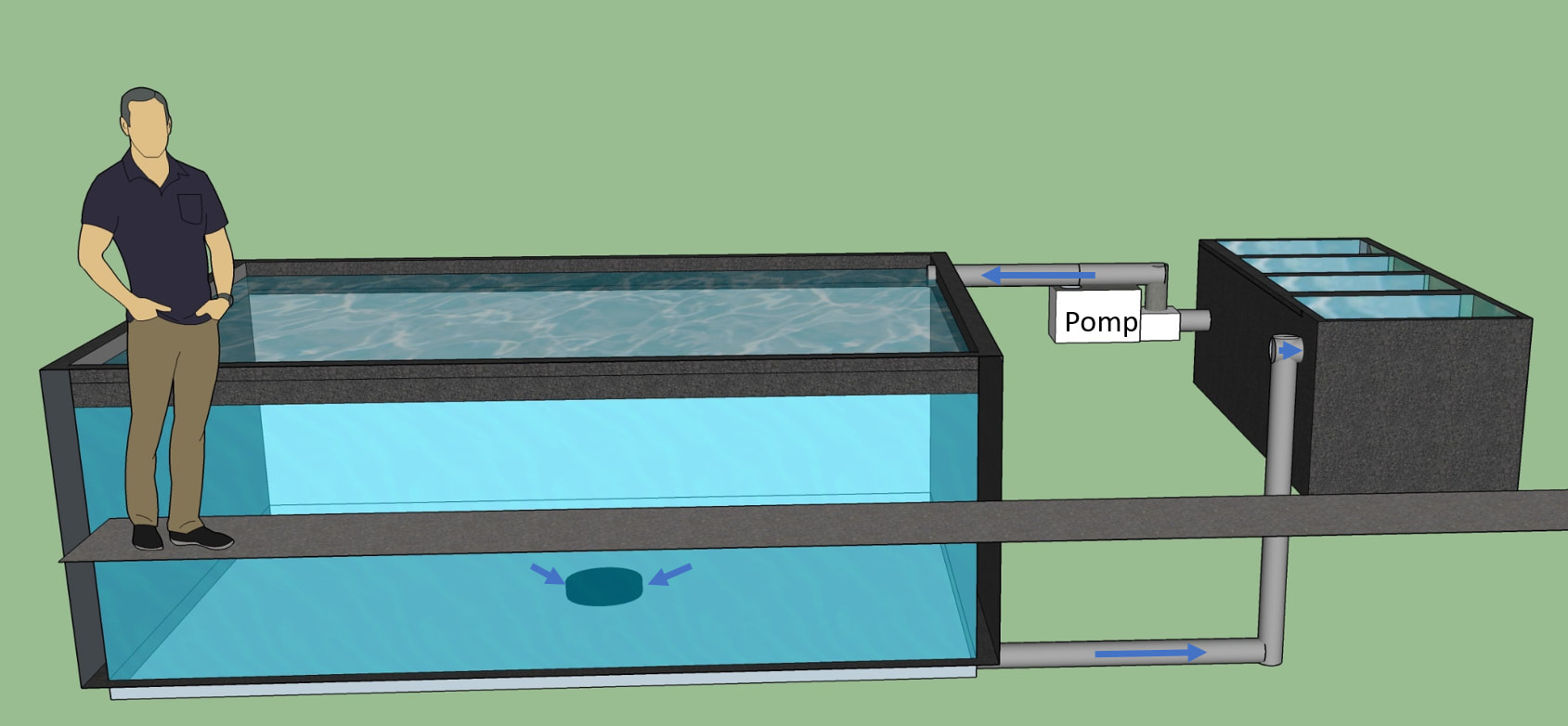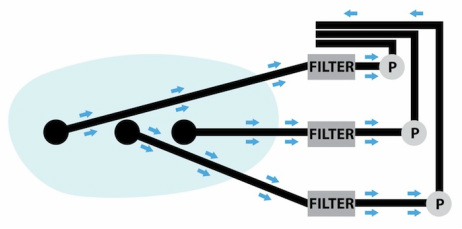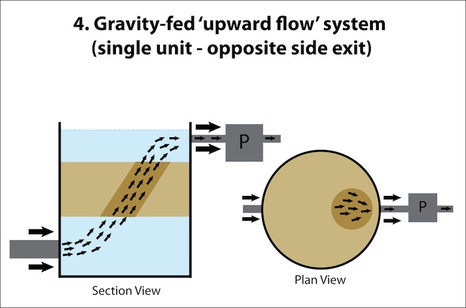Filter systems.
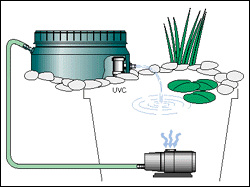
Pump fed system
One can compare the pump and filter system as the heart and soul of your pond.
There are 2 ways to connect the pump and filter with a pond.
Either using a pump fed system, or a gravity system.
First pump fed system. This is the start of many Koi keepers. Mostly goldfish ponds were the first nice coloured carp are thrown in to. A pump in the pond water displaces water to a filter that is usually above the water level of the pond. After the filter (usually small barrels or similar, sometimes expensive, junk) water falls naturally back into the pond.
Many beginners in the hobby choose for this quick method to apply a filter to the pond. With this method, however, you will never get all the dirt from the pond which thus accumulates and will cause problems. with a few goldfish this will go well for a long time, and even keep a clear pond. When introducing more then 1 or 2 Koi in such a system, over time this does not go well. the pump clogs, lots of algea, and even dead Koi happen, suddenly, and sometimes all of them.
I can go ok for a long time, but that requires good maintenance from the owner, you, a lot of extra, daily work.
A schematic of Pump fed system:
There are 2 ways to connect the pump and filter with a pond.
Either using a pump fed system, or a gravity system.
First pump fed system. This is the start of many Koi keepers. Mostly goldfish ponds were the first nice coloured carp are thrown in to. A pump in the pond water displaces water to a filter that is usually above the water level of the pond. After the filter (usually small barrels or similar, sometimes expensive, junk) water falls naturally back into the pond.
Many beginners in the hobby choose for this quick method to apply a filter to the pond. With this method, however, you will never get all the dirt from the pond which thus accumulates and will cause problems. with a few goldfish this will go well for a long time, and even keep a clear pond. When introducing more then 1 or 2 Koi in such a system, over time this does not go well. the pump clogs, lots of algea, and even dead Koi happen, suddenly, and sometimes all of them.
I can go ok for a long time, but that requires good maintenance from the owner, you, a lot of extra, daily work.
A schematic of Pump fed system:
Gravity systems: a schematic view
Gravity system
The only good choice for a Koi pond is a system where bottom drains are used to collect water and dirt from the pond which goes into a first filter chamber, before a pump will eventually pump the purified water back into the Koi pond.
It will make life easier for the pond pretty much cleans itself. one only needs to clean the first part of the filter. And if a sieve or drumfilter is used, then cleaning these once a week is enough to maintain clear water.
the water level in the filter is the same as in the pond, hence the gravity term.
A lot more explanation about filters, design and workings can be found in the free NVN Koi app. calculations and information that will help Koi keepers a lot to improve or plan there Koi pond ahead, before money is spend on systems that prove not good enough.
For people that are a little further with their plans to build a pond and filter system, I recommend 2 evenings or so to read the site of Peter Waddington. Well, it will take 2 nights just to completely read the section on filters and proper construction of a good pond, but it's worth it to save you from hours of cursing over a wrong pond design.
Waddy's experience in the field is nearly unequalled so lots of beginners mistakes can be skipped after reading.
I also believe in; The 1 to 1 drain filter principle! although I can also understand that finacially this is not an option for everyone.
Http :/ / koikichi.com / understanding-modern-day-principles-of-perfect-pound-design /
The only good choice for a Koi pond is a system where bottom drains are used to collect water and dirt from the pond which goes into a first filter chamber, before a pump will eventually pump the purified water back into the Koi pond.
It will make life easier for the pond pretty much cleans itself. one only needs to clean the first part of the filter. And if a sieve or drumfilter is used, then cleaning these once a week is enough to maintain clear water.
the water level in the filter is the same as in the pond, hence the gravity term.
A lot more explanation about filters, design and workings can be found in the free NVN Koi app. calculations and information that will help Koi keepers a lot to improve or plan there Koi pond ahead, before money is spend on systems that prove not good enough.
For people that are a little further with their plans to build a pond and filter system, I recommend 2 evenings or so to read the site of Peter Waddington. Well, it will take 2 nights just to completely read the section on filters and proper construction of a good pond, but it's worth it to save you from hours of cursing over a wrong pond design.
Waddy's experience in the field is nearly unequalled so lots of beginners mistakes can be skipped after reading.
I also believe in; The 1 to 1 drain filter principle! although I can also understand that finacially this is not an option for everyone.
Http :/ / koikichi.com / understanding-modern-day-principles-of-perfect-pound-design /
Also, his theory and experience on how a filter works is very interesting;
An example is the flow of water described by a "normal" filter and thus an example of how it should not be done. One fast improvement is putting the matting filter medium in a honeycomb shape, not crammed together in one pack.
A solution a also the moving bed;
http://koikichi.com/water-flow-patterns/
Dutch version;
http://www.ericfilters.nl/index.php?option=com_content&view=article&id=36&Itemid=100
In the drawings below you can see how the water moves through a filter which runs for a while. You see that there is only a small piece of the whole filter surface thats used effectively.
What I find particularly smart about the eric filters is the 110mm discharge which is very efficient in removing dirt combined with the philosophy that it should be done daily. This will make sure that dirt will never accumalate and the daily refresh of water (every day 1%) will ensure a beautiful clear pond. Personally I do think that if this philosophy is applied with other filter systems, like a sieve and moving bed, the same strong improvement will be seen in the pond.
An example is the flow of water described by a "normal" filter and thus an example of how it should not be done. One fast improvement is putting the matting filter medium in a honeycomb shape, not crammed together in one pack.
A solution a also the moving bed;
http://koikichi.com/water-flow-patterns/
Dutch version;
http://www.ericfilters.nl/index.php?option=com_content&view=article&id=36&Itemid=100
In the drawings below you can see how the water moves through a filter which runs for a while. You see that there is only a small piece of the whole filter surface thats used effectively.
What I find particularly smart about the eric filters is the 110mm discharge which is very efficient in removing dirt combined with the philosophy that it should be done daily. This will make sure that dirt will never accumalate and the daily refresh of water (every day 1%) will ensure a beautiful clear pond. Personally I do think that if this philosophy is applied with other filter systems, like a sieve and moving bed, the same strong improvement will be seen in the pond.
